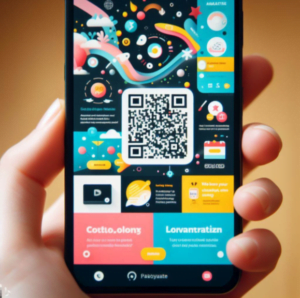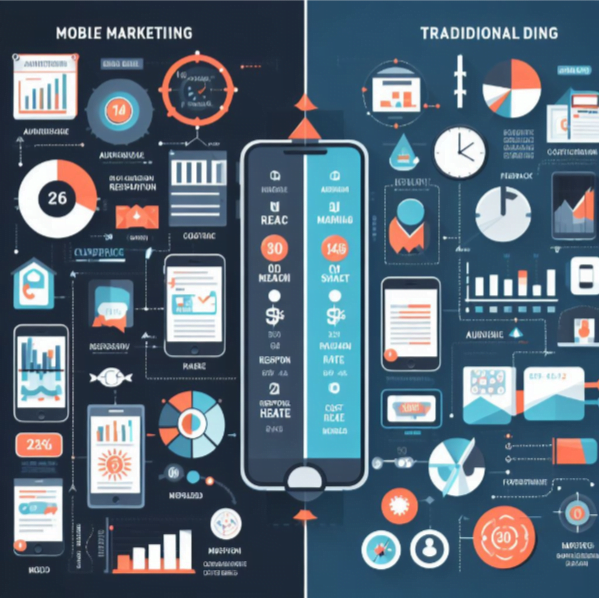Mobile marketing works by connecting with customers through their mobile devices encouraging them to interact with your brand. Here are some types of mobile marketing:

In-App Marketing: In-app marketing refers to marketing efforts conducted within mobile apps. It can involve promoting your own brand or advertising other brands. For your own brand, in-app marketing includes using banners, overlays, and inbox messaging to market your products to app users. This allows you to engage with active users of your app and guide their experience within your app. Alternatively, you can include ads within popular apps or your brand’s own app. These ads can take the form of banners, full-page visuals, or videos. In-app marketing also provides opportunities to expand your customer base through advertisements placed on popular apps.
Mobile Push Marketing: Mobile push marketing involves sending marketing messages to mobile devices using push technology. Push notifications enable you to deliver relevant information to users even when they are not actively using your website or app. These notifications offer a simple and effective way to communicate with both existing and potential customers.
SMS Marketing: SMS marketing involves running marketing campaigns through text messages. You can send promotions, alerts, offers, and more directly to current and potential customers’ phones. SMS marketing campaigns can be highly effective since most people have their phones with them at all times, and it is difficult to ignore push notifications.
Social Media Marketing: With billions of users on various social media platforms, social media marketing provides an excellent opportunity to advertise and promote your business. It enables you to establish a more personal connection with consumers through platforms such as Facebook ads, promoted tweets, or shoppable pins on Pinterest.
Location-Based Marketing: Location-based marketing allows you to target customers on their mobile devices based on their location. By creating specific marketing campaigns tailored to your customers’ location, you can make your marketing efforts more relevant and targeted.
QR Code Marketing: QR code marketing allows you to create a scannable code that links to your website, app download, business reviews, or newsletter sign-up. Customers can simply scan the QR code using their smartphone camera, making it a user-friendly and versatile marketing tool. QR code marketing can be used for various marketing purposes and helps engage a wider audience.
These mobile marketing strategies offer diverse ways to engage with your target audience and promote your brand effectively. By leveraging these techniques, you can reach users through their preferred channels and enhance your overall marketing efforts.

Here are some key differences between mobile and traditional marketing :
- Audience Reach: Traditional marketing reaches a broader audience, while mobile marketing enables businesses to target specific customer segments.
- Audience Engagement: In traditional marketing, customers cannot directly respond to the advertisements as it is a one-way message. In contrast, mobile marketing allows customers to interact with the content and engage with the business.
- Time: Traditional marketing campaigns have a limited lifespan, and once an ad stops running, its impact diminishes. On the other hand, mobile marketing exists online indefinitely, making it a more long-term strategy.
- Measurability: Measuring the success of traditional marketing campaigns can be challenging. In contrast, mobile marketing campaigns are easier to measure as they target specific audiences, allowing businesses to track engagement and conversion rates more effectively.
Pros and Cons
Mobile marketing offers several advantages for businesses to connect with their target audience and run effective marketing campaigns. These advantages include:
- Accessibility and Immediacy: Mobile marketing allows businesses to reach their audience anytime and anywhere, providing a quick and convenient way to communicate with customers.
- Global Audience: With the widespread use of mobile phones worldwide, businesses can reach customers globally, expanding their reach and potential customer base.
- Multiple Channels: Mobile marketing offers various channels to engage with customers, including websites, apps, text messages, and social media platforms, providing flexibility and multiple opportunities to connect with the target audience.
- Personalization: Mobile devices are highly personalized to users, making the marketing communication feel more personal to customers. This personal touch can enhance customer engagement and improve the customer experience.
- Viral Potential: Mobile marketing content can easily be shared, allowing for the potential of viral exposure and gaining wider reach for the business’s marketing efforts.
However, there are also some disadvantages to consider when implementing mobile marketing strategies:
- Little Room for Error: Mistakes in mobile marketing campaigns may quickly be seen by customers, leaving little opportunity to rectify errors before it negatively affects the business’s image.
- Bad User Experiences: Poorly executed ads or marketing content can also go viral, which can harm the business’s reputation and result in negative user experiences.
- Navigation Issues: Different mobile devices have varying screen sizes, making it challenging to create standardized ad images that adapt well to all devices. This could limit some users from accessing or interacting with the ad.
- Privacy and Permission: Consumers are increasingly concerned about their privacy on mobile devices. Businesses must respect customer privacy and provide options for opting out of communication to maintain trust and protect customer data.
- Constant Updates: Mobile technology advances rapidly, requiring businesses to stay updated and educate their teams on the latest developments. It also necessitates ensuring that customers can access ads with new updates, creating additional challenges and maintenance efforts.
Understanding both the advantages and disadvantages of mobile marketing can help businesses make informed decisions and develop effective strategies to connect with their target audience effectively.
Mobile Marketing vs. Traditional Marketing

Mobile marketing aims to connect with customers through their mobile devices, while traditional marketing encompasses non-online methods such as newspaper, television, radio, and billboard ads. Unlike traditional marketing that typically involves one-way communication, mobile marketing allows customers to actively engage with businesses through mobile advertisements. To further illustrate the disparities between the two approaches, consider the following examples:
- Audience Reach: Traditional marketing tends to target a broader audience, whereas mobile marketing enables businesses to focus on specific customer segments.
- Audience Engagement: With traditional marketing, customers have limited or no means to directly respond to the message conveyed. Conversely, mobile marketing fosters two-way communication, facilitating customer interaction with the content.
- Time Sensitivity: Traditional marketing initiatives conclude once the respective ad ceases to run, presenting a short-term impact. On the other hand, mobile marketing perpetually exists online, providing a more enduring, long-term strategy.
- Measurability: Traditional marketing campaigns pose challenges when it comes to evaluating success rates accurately. In contrast, mobile marketing campaigns offer easier measurability as they target specific audiences, making it simpler to assess their effectiveness.
To sum up, Mobile marketing is an essential strategy for businesses looking to connect and engage with their target audience in today’s mobile-centric world. By utilizing various channels and techniques such as in-app marketing, mobile push marketing, SMS marketing, social media marketing, mobile search marketing, and mobile advertising, businesses can effectively reach and interact with users on their preferred mobile platforms. By adopting a holistic approach to mobile marketing and aligning strategies with business goals, businesses can increase brand visibility, drive customer engagement, and achieve their marketing objectives in the mobile space.
Contact us to learn more about marketing.
Author
-

Kieran Scott is a Senior Marketing Manager on the blog team with a wealth of experience writing about your favorite social media platforms, sales trends, and how you can keep your customers happy. He’s the sole manager of Breaking the Blueprint, a DI&B blog series dedicated to addressing the unique challenges and opportunities of underrepresented entrepreneurs, growing its traffic by more than 50% in just one year. When he’s away from his keyboard, you’ll probably find him trying new recipes and leaving his heart out on the soccer field. At the same time. He’s based in Brooklyn, NY.
View all posts






